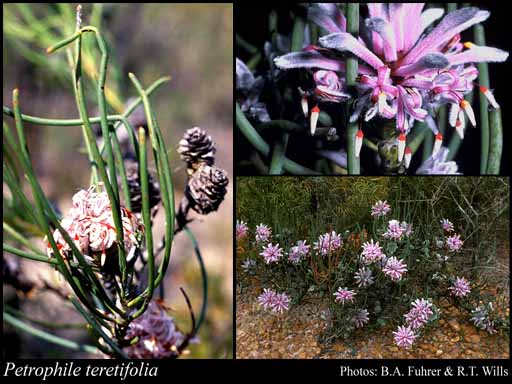- Reference
- Trans.Linn.Soc.London 10:67 (1810)
- Conservation Code
- Not threatened
- Naturalised Status
- Native to Western Australia
- Name Status
- Current
Erect or spreading shrub, 0.1-1(-2) m high. Fl. pink & other/blue-purple-pink, Sep to Dec or Jan. White, grey or brown sand, laterite, sandy clay.







Scientific Description
Shrubs, 0.5-2 m high; branchlets glabrous. Leaves alternate, 40-200 mm long, 1.5-3 mm wide, glabrous; lamina terete, entire, straight or curved, smooth, apex acute, 1-1.5 mm long. Inflorescences not viscid, white or pink. Perianth 17-25 mm long, hairy, the limb apex hairy all over; pistil 17-25 mm long; pollen presenter not fusiform, hairy, 5.5-6.3 mm long, the brush 4.2-4.5 mm long. Cone with persistent scales, 15-25 mm long. Flowers in January, February, March, April, May, June, July, August, September, October, November or December. Occurs in the South-west (SW) Botanical Province(s), in the Jarrah Forest (JF), Mallee (MAL) or Esperance Plains (ESP) IBRA subregion(s).
Distribution
- IBRA Regions
- Esperance Plains, Jarrah Forest, Mallee.
- IBRA Subregions
- Eastern Mallee, Fitzgerald, Recherche, Southern Jarrah Forest, Western Mallee.
- IMCRA Regions
- Eucla, WA South Coast.
- Local Government Areas (LGAs)
- Albany, Cranbrook, Esperance, Gnowangerup, Jerramungup, Plantagenet, Ravensthorpe.